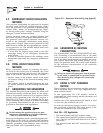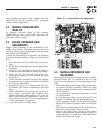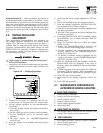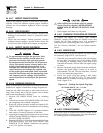
18
FIRST 100 OPERATING HOURS
1. Change engine oil and oil filter. After initial
change, service engine oil and filter at 150 operat-
ing hours or six months, whichever comes first.
2. Retorque cylinder head (see torque specs).
3. Retorque intake and exhaust manifold (see torque
specs).
EVERY 500 OPERATING HOURS
1. Service air cleaner.
2. Check starter.
3. Check engine DC alternator.
EVERY 800 OPERATING HOURS
1. Retorque cylinder head (see torque specs).
2. Retorque intake and exhaust manifold (see torque
specs).
3. Check engine compression.
4. Check valve clearance.
4.2 EXHAUST MANIFOLD PROCEDURE
1. If necessary, clean gasket surfaces on exhaust
manifold and cylinder head.
2. Install exhaust manifold and exhaust manifold
gasket.
3. Install fasteners.
NOTE:
Exhaust manifold fasteners must be tightened in
two stages.
4. Tighten fasteners to 20-30 N-m (15-22 lb-ft) dur-
ing the first stage.
5. Retighten fasteners to 60-80 N-m (44-59 lb-ft)
during the second stage.
4.3 INTAKE MANIFOLD PROCEDURE
1. Clean and inspect the mounting surfaces of the
intake manifold and the cylinder head. Both sur-
faces must be clean and flat (Figure 4.1).
2. Clean and lightly oil the manifold bolt/stud
threads.
Figure 4.1 — Intake Manifold Installation
3. Install a new lower intake manifold gasket.
4. Position the lower intake manifold to the cylinder
head.
5. Install retaining bolts/studs finger tight.
6. Tighten all bolts/studs to specifications in the
tightening sequence shown:
• First pass = 7=10 N-m (5-7 lb-ft).
• Final pass = 26-38 N-m (19-28 lb-ft).
4.4 CYLINDER HEAD PROCEDURE
1. Position head gasket on the block (Figure 4.2).
2. Position cylinder head to cylinder block.
3. Install 10 cylinder head bolts in numerical
sequence. Tighten to 70 N-m (52 lb-ft) in sequence.
Retighten to 70 N-m (52 lb-ft) in sequence. Then
turn all head bolts an additional 90 - 100 degrees
in sequence.
Figure 4.2 — Cylinder Head Installation
4.5 COOLING SYSTEM
Air intake and outlet openings in the generator com-
partment must be open and unobstructed for contin-
ued proper operation. This includes such obstruc-
tions as high grass, weeds, brush, leaves and snow.
Without sufficient cooling and ventilating air flow, the
engine/generator quickly overheats, which causes it
to shut down. (See the installation diagram.)
Section 4 — Maintenance
Liquid-cooled 25 kW Generators


















